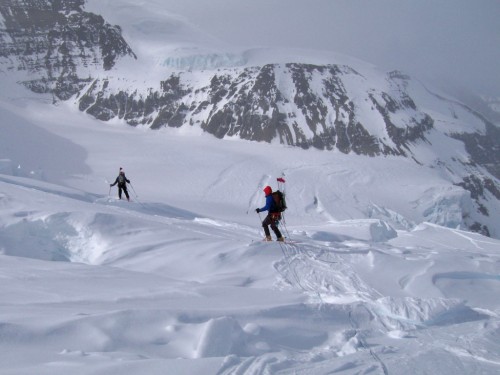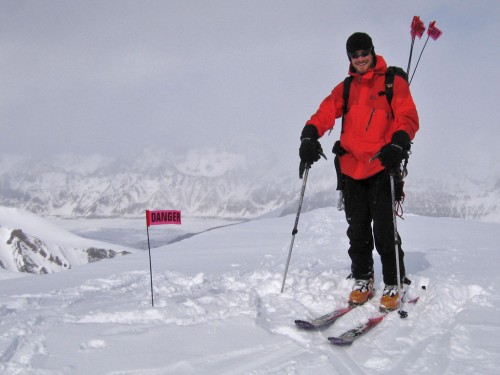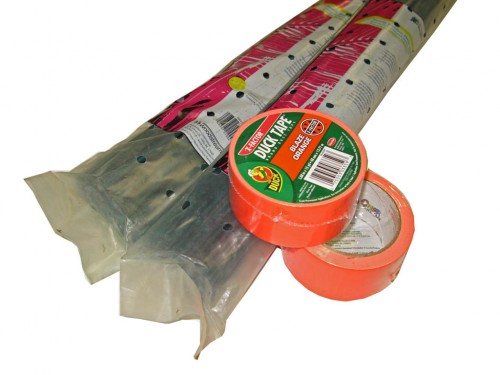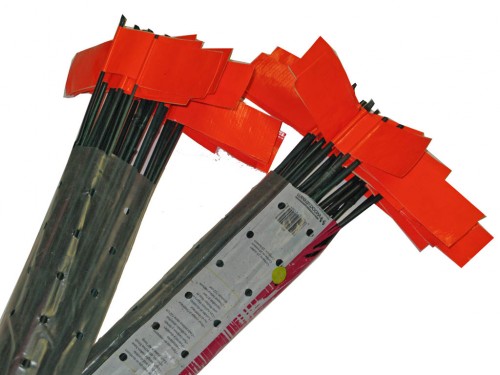Expeditions – Wands
Placing wands in the mountains is a bit of an art. On one hand, you only have a limited number of them, so you don’t want to over-place them, and if it is clear and sunny, there is a temptation to skip placing them as the way up and back is obvious. Because of this, I’ve often summited peaks with a full stash of wands. But, when you do need them, like in a whiteout when you are lost, cold and the sun is going down, coming across a well wanded trail is a total godsend.

Prime wanding terrain on Mt. Bona, AK. We are going down, so we have cleaned the ones we placed on the way up. Crevasses and bridges and cracks - oh my!
Through constructing flagging for ski mountaineering races, I’ve ended up making far more wands/flags than I ever would have thought possible (2,000 or more) and learned what does, or more often, doesn’t work for flags or wands. It is actually a little harder than it looks (or I’m a really, really slow learner).

These wands looked better than they actually worked. The flagging was too big, so the wind either snapped it off or they got tangled up among themselves. Still, it was fun to place a DANGER wand right near a big crevasse, just in case you were thinking of falling in it or something...
For mountaineering, you want a long staff and relatively small flags. The long staff helps as it can handle a snow storm without getting buried, will sink further into the snow if need be and doesn’t require you to bend over as far to place them, which is a big deal with a heavy pack. On the flagging, if it is too big, it will flutter excessively in the wind and either break off or pull the stake out.

Tools of the wanding trade - 48" tomato stakes ($2.57 for a 25 pack) and duct/duck tape ($3.34 per roll, which will do about 50-75 wands). Total cost of about $.11 per wand.
My current wand construction of choice is to buy a few 25-pack bags of 48″ bamboo tomato stakes and some bright duct tape. The duct tape needs to be the burlier cloth back stuff, not the vinyl, which looks like duct tape, but will crack in the cold. For some reason, WalMart is the colored duct tape capital of the universe, and they happened to have bright orange “Duck Tape” brand tape, as well as the tomato stakes.
At the risk of insulting your intelligence, constructing them is very easy. You pull off about 8″ of tape, fold it neatly over, slip the skinner of the two ends of the stake in the loop and squish it shut. Repeat 50 or so times. How many you make will depend a lot on your route. Some routes, like Denali, could use quite a few (long route, lots of cracks), but then again, so many people climb it that it is already pretty well wanded. Wanding is really only helpful if you plan on retracing your steps (like shuttling loads, or for a ski descent), but if you are just moving on, then placing wands is kind of pointless.
Since most people leave their wands with an air taxi service or outfitter when they are done, you can often get them that way as well. I prefer to make my own as the air taxi service may not have them (good luck finding tomato stakes in Chitina, Alaska), they may charge for them, or they may be the ratty Euro versions. Another good reason to make & bring your own is that they will hopefully be a distinctive color, which can be important if you inadvertently start following the wrong wanded route.
As a final wanding thought, beware that everyone tends to place wands a little differently. I try to find big, obvious, open spots for them and mark crevasses with X’d wands, with the idea being that if I am lost, I’ll go from wand to wand. But, some people use them to mark hazards, which which can be exciting if you are not use to it, as every time you come across a wand, you almost fall into a crevasse.
Okay, one more wand item – they make great supports for drying out socks on a nice day. And, you can cut them in half/quarters if need be and bury them as T stakes for tents.
________________________________
Help support StraightChuter.com and carry your wands in a superb Mountain Hardwear South Col Pack on sale now at Backcountry.com. Click on the photo below…
Category: Expeditions











Thanks for the article. What do you do with the wands afterwards on the return trip home? Leave them in the ground, or take them back with you?
Hi Tom – I usually pull them out as I ski down, which is another good reason to have long ones. I usually lose a few to attrition, and then depending on how heavy my return luggage is, I will either take them back home with me, or donate them to the air taxi stash.
Solid info…thanks! I notice that you buy the 48″ bamboo sticks. Do you keep them the full length or do you cut them down?
Another tip to placing wands, and this may seem a little obvious, but it took me breaking a bunch of wands to figure it out, when the snow is hard, use either your ski pole or ice axe to create a pilot hole for the wands, it takes more time, but there is also a better chance that your wand will be there on your return.
With 48-inchers, how much do you recommend to leave exposed? (how deep do you insert)? When I’ve climbed/skied popular routes on Rainier and Hood, I’ve noticed the “guide wands” seemed really short, like 24″ inches or less. I like your recommendation of 48″, just because going short ups the chance of burial due to snow/wind.
OMR – I guess it depends on how deep and/or soft the snow is. If needed, I cram them down pretty far. I’d say in general, I push them down about 12″.
Do you really need wands? I have never seen them used before.
PS Honest question. Never used in mountains of New Zealand, Pakistan or India I have been in.
Hi Duncan – it totally depends on where you are going and what you are doing. I probably wouldn’t use them in New Zealand, but in Alaska or perhaps places like Mt. Rainier, where there are complex, heavily crevassed glaciers which you may have to cross and recross a few times in bad weather or visibility, wands are very helpful.
What about using a GPS to mark route/crevasses? Any try that?
If you are interested in quality materials, super bright fluorescent color, stands tall at 64″, has reflective qualities and also packs down into 2 pieces… then try our 8850m Backcountry Wands available through REI. Your life is worth spending a little extra, thank you!
Just following up on CJ’s question about using GPS to mark the route and crevasses.
While GPS is awesome, in most civilian cases it is not accurate enough to provide the level of safety that one wants in mountaineering.
Since the current standard error for civilian GPS units using normal WAAS differential improvements in accuracy, 3 meters (~10 feet) is pretty much the best accuracy you can expect. So, if you stand 9 feet away from a crevasse, marking this point and your route around the crevasse, and then come back very carefully following your previous GPS-tracked route, you could very possibly walk right into the crevasse simply because of GPS error…
I would not count on GPS for safety in crevasse or cliffed-out terrain where I needed better than 10-foot accuracy to protect my life!
Wands are definitely what you need to use. They are very inexpensive life insurance. :-)
i know this seems like an old thread but i just did a climb of mt saint helens with my son(25) and daughter(22). we noticed many wands on our ascent which was the worms flow winter route. They were not enough to travel from wand to wand but in following the bootpath up we would occasionaly go past a wand. it seems some were red, some orange, and some yellow. at the crator rim there were 2 red or possibly orange wands placed about 2 yards apart as if to form a gate which i instintively took as a warning sign for the crator rim. on the descent we wanted to take the most direct route to the mt marble sno park where the car was parked so we were looking for wands at several junctures. this was on a wednesday jun 13 were only 15 climbing permits were issued so although there were lots of footprints in the snow we were by ourselves most of the time. on one occasion my daughter saw 2 orange or red wands placed next to each other about 1 yard apart and we headed over that way. she got a little too close and fell into a hole in the snow up too her neck, about 5 feet deep. my son and I were able to extract her from this trap but not after many minutes of excitement/panic.